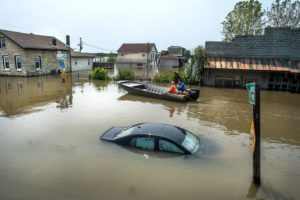
Machine Learning Illuminates Extreme Flooding in the Midwest

Floods just ravaged western Europe, fires are devastating the West Coast, and forecasters are projecting a busier-than-normal Atlantic hurricane season: extreme weather is on the rise, and it’s not going away any time soon. At Stanford, researchers are applying machine learning to understand these extreme weather phenomena – specifically, extreme precipitation and flooding in the Midwest.
“We know that flooding has been getting worse,” said lead author Frances Davenport, a PhD student in Stanford’s School of Earth, Energy & Environmental Sciences, in an interview with Stanford’s Rob Jordan. “Our goal was to understand why extreme precipitation is increasing, which in turn could lead to better predictions about future flooding.”
Midwest flooding accounts for the majority of U.S. flood disasters – hence the researchers’ focus – and the team honed in on areas of the Mississippi and Missouri watersheds, which are particularly prone to flooding even within the Midwest. Using precipitation data from the last 40 years, the researchers trained a machine learning algorithm oriented around grid data to recognize the circulation patterns that accompany extreme precipitation.
The trained algorithm proved highly accurate. “The algorithm we use correctly identifies over 90 percent of the extreme precipitation days, which is higher than the performance of traditional statistical methods that we tested,” Davenport said. Furthermore, the researchers were able to leverage the algorithm to better understand the causal factors on a meteorological and climatological level: atmospheric pressure patterns that have been steadily increasing year-over-year, high atmospheric moisture flowing from the Gulf of Mexico, and more.
Next, the researchers are aiming to broaden their approach, examining a greater spatiotemporal range of extreme weather. “While we focused on the Midwest initially, our approach can be applied to other regions and used to understand changes in extreme events more broadly,” Davenport said. “This will help society better prepare for the impacts of climate change.” To that end, the researchers are also planning to project how extreme weather events will play out in the future.
“This new approach to leveraging machine learning techniques is opening new avenues in our understanding of the underlying causes of changing extremes,” said co-author Noah Diffenbaugh, the a professor in Stanford’s School of Earth, Energy & Environmental Sciences. “That could enable communities and decision makers to better prepare for high-impact events, such as those that are so extreme that they fall outside of our historical experience.”
To learn more, read the paper here and the reporting from Stanford’s Rob Jordan here.































